Fourth of July for the Harmonica!
July 2013
By Virginie Ternisien, MAC Lab Conservator
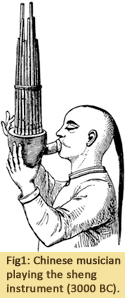 The harmonica is a free reed wind instrument. As the player exhales (blows) and inhales (draws) air into evenly-spaced air channels, the reeds within produce a musical tone by vibrating when air is applied. Because it is small, compact, pre-tuned, very affordable and transportable, the harmonica has reached a wide popularity throughout the world in every musical genre.
The harmonica is a free reed wind instrument. As the player exhales (blows) and inhales (draws) air into evenly-spaced air channels, the reeds within produce a musical tone by vibrating when air is applied. Because it is small, compact, pre-tuned, very affordable and transportable, the harmonica has reached a wide popularity throughout the world in every musical genre.
Also called "French harp", "pocket piano" or "mouth organ", it has become an iconic instrument in the United States since the end of the nineteenth century, featured in American folk music. It was played by soldiers at the front lines during the Civil War (1861–1865) and even by Abraham Lincoln, president of the United States. A letter addressed to the head of the Hohner Harmonica Company reveals his hobby: “Two of my favorite things are sitting on my front porch smoking a pipe and playing my Hohner harmonica”.
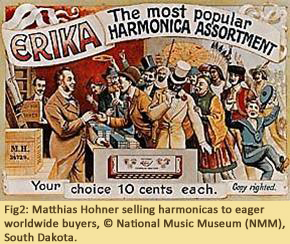 The history of the harmonica goes back to Asia thousand years ago from the Chinese sheng (Figure 1), a sacred instrument introduced in Europe in the late eighteenth century. The harmonica, as we know it today, first became prominent in the early nineteenth century in Trossingen, Germany. In 1857, a German clock maker, Matthias Hohner, started mass production and in 1862 he began to supply North America. It propelled the Hohner Company to reach the status of world leader in harmonicas by 1887, with the production of more than one million harmonicas annually (Figure 2).
The history of the harmonica goes back to Asia thousand years ago from the Chinese sheng (Figure 1), a sacred instrument introduced in Europe in the late eighteenth century. The harmonica, as we know it today, first became prominent in the early nineteenth century in Trossingen, Germany. In 1857, a German clock maker, Matthias Hohner, started mass production and in 1862 he began to supply North America. It propelled the Hohner Company to reach the status of world leader in harmonicas by 1887, with the production of more than one million harmonicas annually (Figure 2).
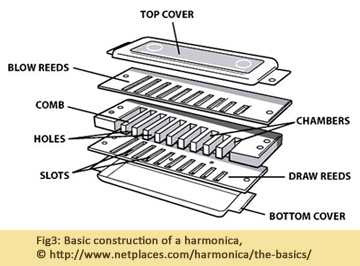 Every type of harmonica consists of three essential components: one body or comb, two reed plates and two cover plates (Figure 3), held together with nails or screws. Harmonicas can be made from wood and metal (and plastic for the recent ones), or a combination of these materials, to create specific tonal characteristics and aesthetic features. Bells, horns or metal side plates were added by makers on the exterior of the instrument in an effort to develop innovation in a competitive market. Harmonica holders were also produced to allow the musician to play another instrument at the same time.
Every type of harmonica consists of three essential components: one body or comb, two reed plates and two cover plates (Figure 3), held together with nails or screws. Harmonicas can be made from wood and metal (and plastic for the recent ones), or a combination of these materials, to create specific tonal characteristics and aesthetic features. Bells, horns or metal side plates were added by makers on the exterior of the instrument in an effort to develop innovation in a competitive market. Harmonica holders were also produced to allow the musician to play another instrument at the same time.
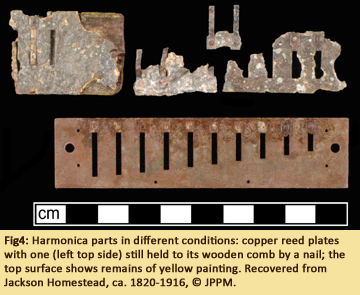 Archaeological examples of harmonicas (Figure 4) often consist of corroded copper alloy reed plates and cover plates, fragmented and deformed. The original surface appearance is lost, transformed into green-colored patinas or crusts. Remains of inscriptions can be preserved, revealing the date of production and the manufacturer. Also, when fragments of the wooden comb are found, their structure has shrunken and warped in response to environmental moisture content. Sometimes, they are still held to the metal parts by corroded iron nails or adhered to the metal surface by copper salts. Since copper is a biocide material, it likely decreases the biodeterioration of the wooden components (Cronyn 1990: 219-220). Copper salts frequently impregnate their structure, staining them green. Historical sources such as American store catalogues [The Montgomery Ward & Company (1872–2000) or The Sears, Roebuck & Company (1888-1993)] and harmonicas gathered
Archaeological examples of harmonicas (Figure 4) often consist of corroded copper alloy reed plates and cover plates, fragmented and deformed. The original surface appearance is lost, transformed into green-colored patinas or crusts. Remains of inscriptions can be preserved, revealing the date of production and the manufacturer. Also, when fragments of the wooden comb are found, their structure has shrunken and warped in response to environmental moisture content. Sometimes, they are still held to the metal parts by corroded iron nails or adhered to the metal surface by copper salts. Since copper is a biocide material, it likely decreases the biodeterioration of the wooden components (Cronyn 1990: 219-220). Copper salts frequently impregnate their structure, staining them green. Historical sources such as American store catalogues [The Montgomery Ward & Company (1872–2000) or The Sears, Roebuck & Company (1888-1993)] and harmonicas gathered 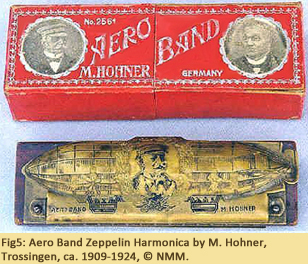 by collectors (Peter Kassan, Alan G. Bates, Figure 5) provide precious information for archaeologists confronted by harmonicas disfigured through use and then aged in a burial environment.
by collectors (Peter Kassan, Alan G. Bates, Figure 5) provide precious information for archaeologists confronted by harmonicas disfigured through use and then aged in a burial environment.
With a great variety of types and tunings, harmonicas allow the player freedom of expression in all forms of music, from classical and blues, to country and rock, to the music of people worldwide, deeply in harmony with the spirit of the American Independence Day, celebrated on July 4th. So, "Please, love me do…"
| References |
|
| Cronyn, J. M. |
| 1990 |
The Elements of Archaeological Conservation. Routledge. London. |
|
| Harter, J. |
| 1980 |
Music, a Pictorial Archive of Woodcuts & Engravings: 841 Copyright-free Illustrations for Artists & Designers. Dover Publications. New York. |
|
| Montgomery Ward |
| 1969 |
Montgomery Ward & Company Catalogue and Buyers' Guide 1895. Dover Publications. New York. |
|
| Sears, Roebuck and Company |
| 1986 |
The 1902 Edition of the Sears Roebuck Catalogue. Bounty Books. New York. |
| 1970 |
The 1927 Edition of the Sears Roebuck Catalogue. Bounty Books. New York. |
|
Harmonica history and construction: |
|
http://www.patmissin.com/history/history.html |
|
http://www.ksanti.net/free-reed/essays/mouthful.html |
|
http://www.bluzkat.com/harphist.htm |
|
http://orgs.usd.edu/nmm/ |
Recommended Museums: |
|
National Music Museum, South Dakota;
Alan G. Bates Harmonica Collection; http://orgs.usd.edu/nmm/ |
|
|
National Museum of American History, Washington D. C.;
Peter Kassan Harmonica Collection |
|
|
The Music Man Square, Meredith Willson Museum, Iowa;
Alan G. Bates Harmonica Collection; http://www.themusicmansquare.org/ |
|
|
The Deutsches Harmonika Museum, Trossingen, Germany;
http://www.harmonika-museum.de/ |
|